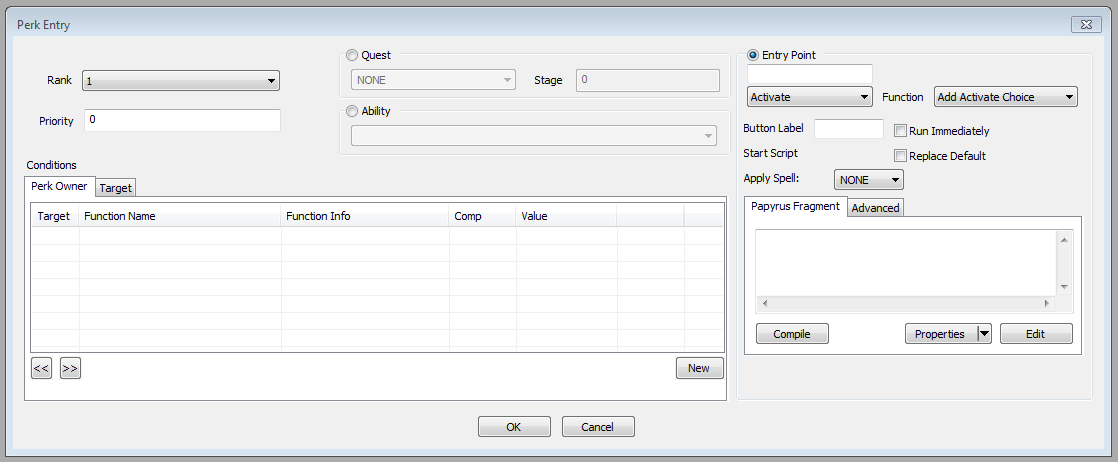Perk
Revision as of 21:37, 2 December 2018 by imported>Qazaaq (Added some description details.)
Type: PERK ![]()
Papyrus: Perk Script, Perk Fragments
Perks are abilities applied to Actors in a similar manner as Spells. The player will encounter these as they gain levels and play through the game. If a Perk has more than one allowable rank, then the player may increase its rank instead of picking a new Perk. Increasing a Perks rank will typically improve its effectiveness.
Editor Dialog
- ID: The ID, also referred to as Editor ID, is used by the Creation Kit to uniquely identify this record within a Data File.
- Name: This object's name as it will appear within user interface menus or when the player looks at it. The character limit is 40, including spaces.
- Perk Description: The object's description as it will appear within user interface menus.
- Icon: The Texture File that will be used for this object's icon. This property is depreciated, obsolete, or does not appear to be used by the game.
- Sound: The Sound Descriptor to play.
- SWF: The Flash File to display.
- Flags
- Trait:
- Playable: If checked, this object will be usable by the player. The object may be visible in user interface menus or usable when encountered within the game world. When enabled, the perk can be chosen by the player when leveling up.
- Hidden:
- Level:
- Num Ranks:
- Next Perk:
- Papyrus Scripts: Papyrus scripts may be added, removed, and their properties edited.
- Add: Adds a papyrus script to this object.
- Remove: Removes the selected papyrus script from this object.
- Properties: Shows the papyrus property editor for the selected script.
- Level-Up Menu Conditions: The Conditions must be met. When conditions are met this perk may be available during level up. Usually these are
GetBaseActorValueandHasPerkconditions. - Perk Entries: A collection of perk entries belonging to this perk. These define what happens if the player has this Perk.
Perk Entry Dialog
- Rank:
- Priority: Controls the precedence for this object. Used to control order of operations when the two perk entries affect the same value. Perks with a higher priority take precedence.
- Quest: The Quest to start with this perk entry.
- Stage: The stage to start the given quest at for this perk entry.
- Ability: The Spell ability to start with this perk entry.
- Entry Point: A Perk Entry Point allows you to modify a specific, predefined part of the code, each with a number of arguments that are relevant to that entry point. Entry points are hardcoded and cannot be created.
- Conditions: The Conditions must be met. For example, a condition here allows you to specify that the perk only functions if the player's health is below 50%, or only works if they have a specific weapon equipped.
- Perk Owner: The conditions are evaluated against the perk owner.
- Target: The conditions are evaluated against the perk target.
- Function: How the Entry Point is affected: plus, minus, multiply, set, etc.
- Function Data: Text, script, or numeric data used when applying the entry point.
- Conditions: The Conditions must be met. For example, a condition here allows you to specify that the perk only functions if the player's health is below 50%, or only works if they have a specific weapon equipped.

